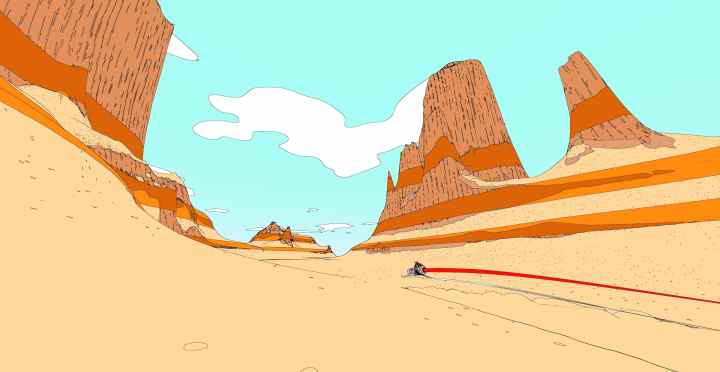I’m soaring across the desert on my glider. I don’t know where I am or how far I am from my destination — I’m not even sure I know what it’ll look like when I get there. All that matters, at this moment, is the whine of my hoverbike’s engine. With nothing to do but drive, I listen to its constant mechanical wheeze closely. I can’t decide if I’m sitting on an advanced piece of sci-fi tech or a total lemon. All I know is that it sounds like it’s putting all its efforts into getting me where I need to be.
Then I notice the music. It’s a minimalist track with steady percussion thumping like a heartbeat. Is it actually music at all? Or am I hearing my own body as it tries to put a beat to my bike’s engine, providing it a tempo to breathe along to? The barrier between human and machine melts away for the rest of my ride; my bike and I are one.
Little moments of audio bliss like that happen all the time in Sable, if you listen closely enough. The indie game may immediately draw attention with its striking art style, but its sound design deserves the best pair of headphones you can find.
The language of machines
Developed by Shedworks, Sable is an open-world game set in a sprawling desert. Players control the titular Sable, a girl who sets out on a coming-of-age ritual that separates her from her clan. Armed with a bike, a newfound gliding power, and the ability to climb any surface, she travels the desert in search of masks that will help her complete her rite of passage. The game mostly plays out as a series of loose quests, where Sable finds bugs for distant villagers or scales massive structures.
As an open world, the desert is particularly empty. There aren’t secrets hiding at the top of every dune. Instead, Sable will spend a lot of time zipping across large empty spaces until a point of interest appears on the horizon. With so much time spent peacefully gliding, sound becomes fundamental to the experience. There’s not much else to focus on in those moments, so my ear starts to hear every little detail. When my bike passes over a dune and comes swooping back down, I can hear the metal briefly dip into the sand before regaining its composure. It’s like the machine is talking to me as I drive, always assuring me that it’ll keep plugging along as long as I need it to.
That level of detail exists even when I’m off my bike. The sound design blends the mechanical and natural, creating an otherworldly, but familiar soundscape. By pressing Y, I can call my bike and summon it to my location (like a horse in Ghost of Tsushima, though it returns to me with much less grace). When I do that, Sable puts two fingers to her mouth and whistles, but it’s not the sound I expect to hear. Rather than a high-pitched melody, she emits a sharp sound, like a piece of malleable metal wobbling after getting hit with a hammer. At first, I’m not even sure if I’m making that sound or if it’s coming from my bike.

The machine quickly responds to my robotic call. I hear its engine excitedly fire up far in the distance before it softly glides over to me like an obedient dog. I feel like my bike and I are speaking the same language, one that I somehow understand, too.
A desert symphony
Another major piece of the soundscape is the game’s original soundtrack, which was composed by Michelle Zauner of indie rock band Japanese Breakfast. Most of her work here is instrumental, though she lends her voice to a stunning track called Glider. The song drops when Sable first leaves her village and the game’s title splashes on screen. A shimmering synth line bubbles up and Zauner sings, “I’m caught between the wind and parts of the unknown; a door between two worlds.” It’s a line that sets up the game’s entire audio motif as natural sounds start to blend into a world full of machines and unexplainable phenomena.
Just as the sound effects give life to my glider, Zauner’s subtle compositions turn each sector of the sprawling desert into its own character. In Sable’s village, a gentle acoustic guitar track is warm and comforting, like home. Elsewhere, I stumble into an abandoned spacecraft filled with machinery. The music is much more unfamiliar here. It’s more scattered, with backwards synth textures indicating that I’ve stumbled on something alien (and as the music foreshadows, I do end up making a surprising sci-fi discovery here).
The music and sound effects are often in concert with one another. In the mechanical area I just mentioned, I use power cores to turn on some heavy machinery. A giant cube heavily juts out of a device with a metallic thud that echoes through the abandoned ship. It’s almost like a distorted bass drum joining in with the music. Everything is one living desert ecosystem functioning together as one.

Sable is a lo-fi symphony that rewards those who keep their ears perked. Climb to the highest point you can find and listen to the flocks of birds squawking above. Stand next to a village’s rudimentary windmills and hear them creak as they rotate. The open world may seem desolate, but it’s busier than it looks. Just listen.
Sable releases on September 23 for PlayStation 4, PS5, PC, Xbox One, and Xbox Series X/S. It will be available as part of Xbox Game Pass on day one.



